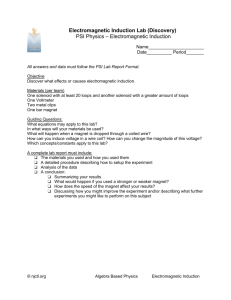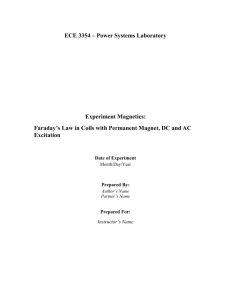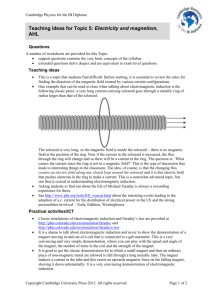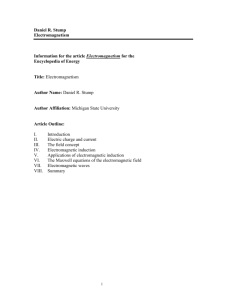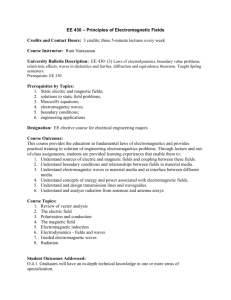File
advertisement
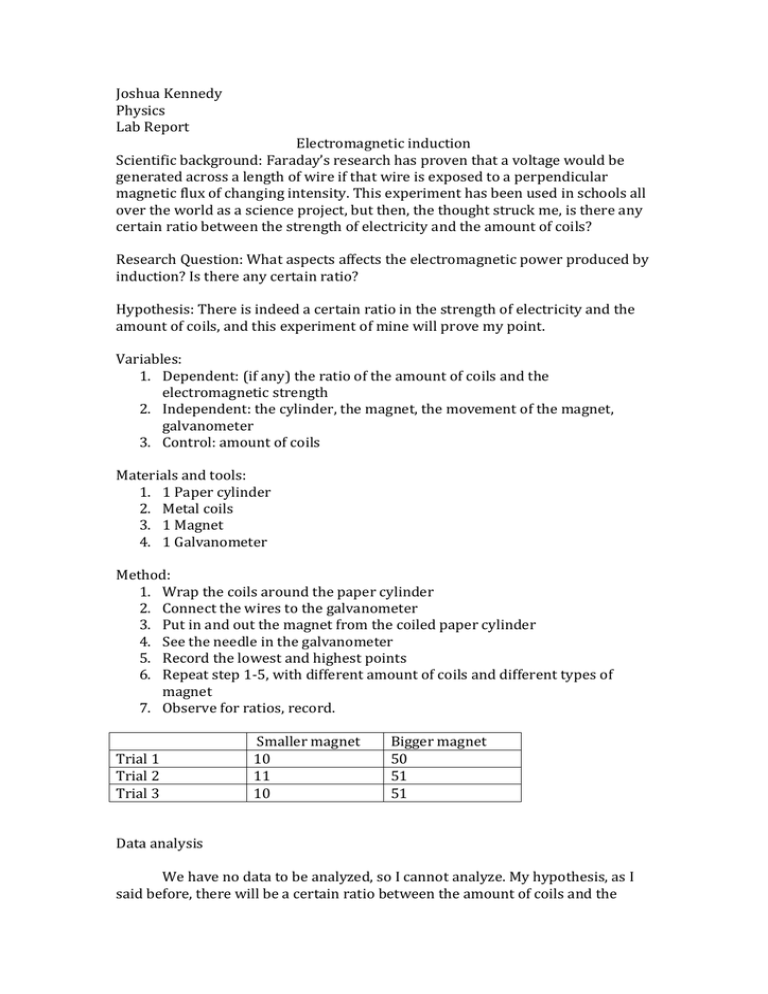
Joshua Kennedy Physics Lab Report Electromagnetic induction Scientific background: Faraday’s research has proven that a voltage would be generated across a length of wire if that wire is exposed to a perpendicular magnetic flux of changing intensity. This experiment has been used in schools all over the world as a science project, but then, the thought struck me, is there any certain ratio between the strength of electricity and the amount of coils? Research Question: What aspects affects the electromagnetic power produced by induction? Is there any certain ratio? Hypothesis: There is indeed a certain ratio in the strength of electricity and the amount of coils, and this experiment of mine will prove my point. Variables: 1. Dependent: (if any) the ratio of the amount of coils and the electromagnetic strength 2. Independent: the cylinder, the magnet, the movement of the magnet, galvanometer 3. Control: amount of coils Materials and tools: 1. 1 Paper cylinder 2. Metal coils 3. 1 Magnet 4. 1 Galvanometer Method: 1. Wrap the coils around the paper cylinder 2. Connect the wires to the galvanometer 3. Put in and out the magnet from the coiled paper cylinder 4. See the needle in the galvanometer 5. Record the lowest and highest points 6. Repeat step 1-5, with different amount of coils and different types of magnet 7. Observe for ratios, record. Trial 1 Trial 2 Trial 3 Smaller magnet 10 11 10 Bigger magnet 50 51 51 Data analysis We have no data to be analyzed, so I cannot analyze. My hypothesis, as I said before, there will be a certain ratio between the amount of coils and the power of electricity. I can prove this, because with the coiled cylinders given by the teacher, the one with more coils produce more electromagnetic power than the one with less coils, even though the one with less coils is wrapped with thicker and longer coil. So, my analysis is, the amount of coils affect the electromagnetic power more than the width of the coil. The magnetic power also affects the electromagnetic power produced, quite significantly. Because, when we tried it with 2 different magnets, the result is significantly different. The first magnet we used is a small magnet, which magnetic power has reduced due to time. The readings said, the smaller magnet produced approximately 10 microamperes of electromagnetic power. While the bigger magnet produced approximately 50 microamperes of electromagnetic power. We did the test with only one cylinder because the other cylinder wasn’t big enough for the big magnet to enter. Conclusion In my research question it is asked what kinds of aspects affect the electromagnetic power produced by electromagnetic induction, and, although not completely, and kind of vaguely, my experiment has answered it. My conclusion is, the factors affecting the electromagnetic power are the magnetic power of the magnet itself, and the amount of coils. I think the magnetic power affects the electricity because it improves the friction between the energy, and results in higher resistance (ampere). The coils also improves the electromagnetic power because if you have more coils you will have more magnetic force traveling thru more vectors, resulting in more electromagnetic power. Evaluation This experiment has failed, initially I wanted to look for ratios, but without being able to count the coils, it cannot be done. So, we looked for another initiative, that is looking for aspects affecting the electromagnetic power produced. We tried our best, but without the proper materials and tools needed, we cannot go further down the road. To improve this, next time we must be completely sure we can find the needed materials and tools before deciding on the experiment. To put it more simply, we must be more prepared, so that mistakes like these wont happen in the future. We hope that with enough preparations we can improve the quality of our data and our experiments. Bibliography "Induced Current and Magnetic Field." Electromagnetic Induction, Magnetic Effects of Electric Current. Web. 24 May 2012. http://www.tutorvista.com/content/science/scienceii/magnetic-effects-electric-current/electromagneticinduction.php
